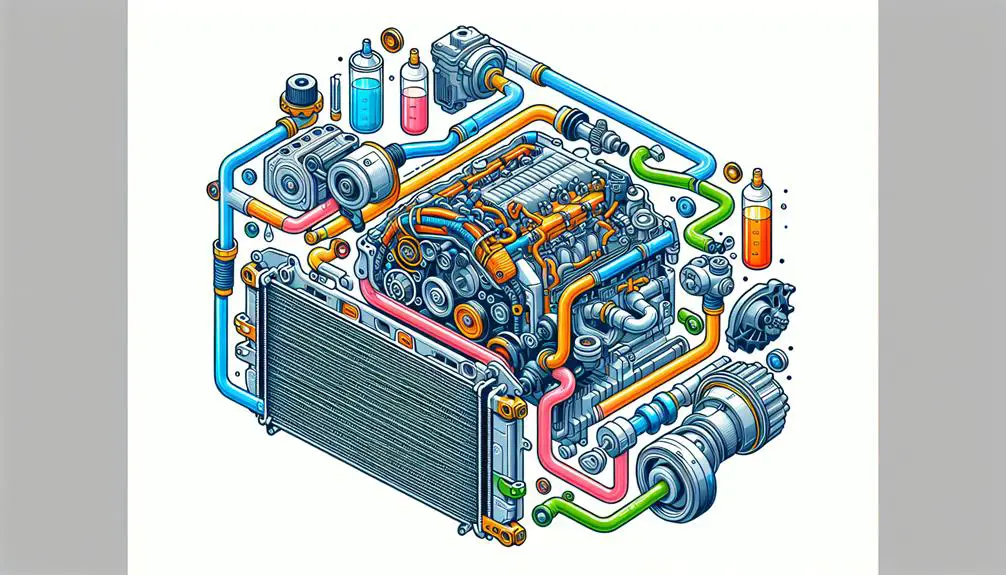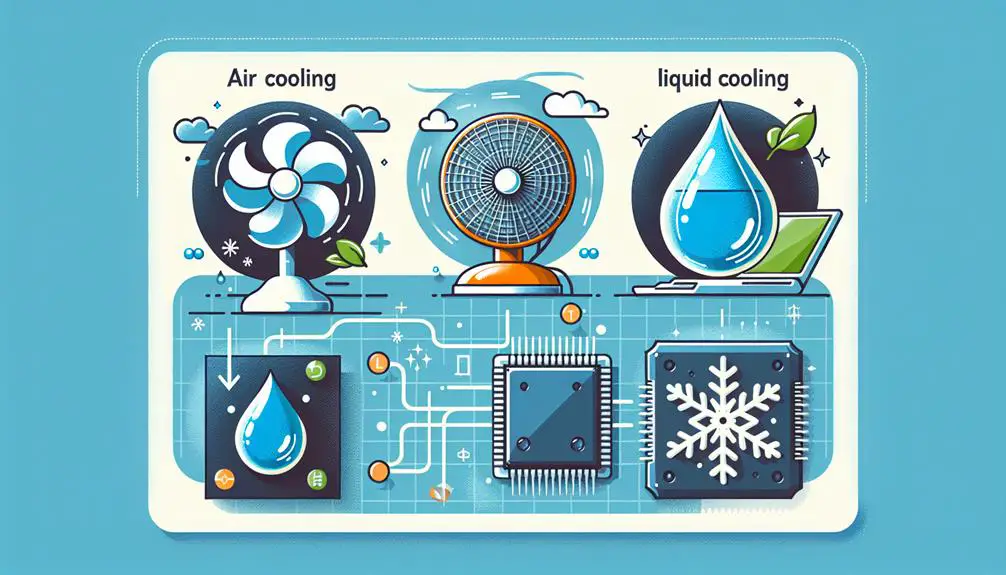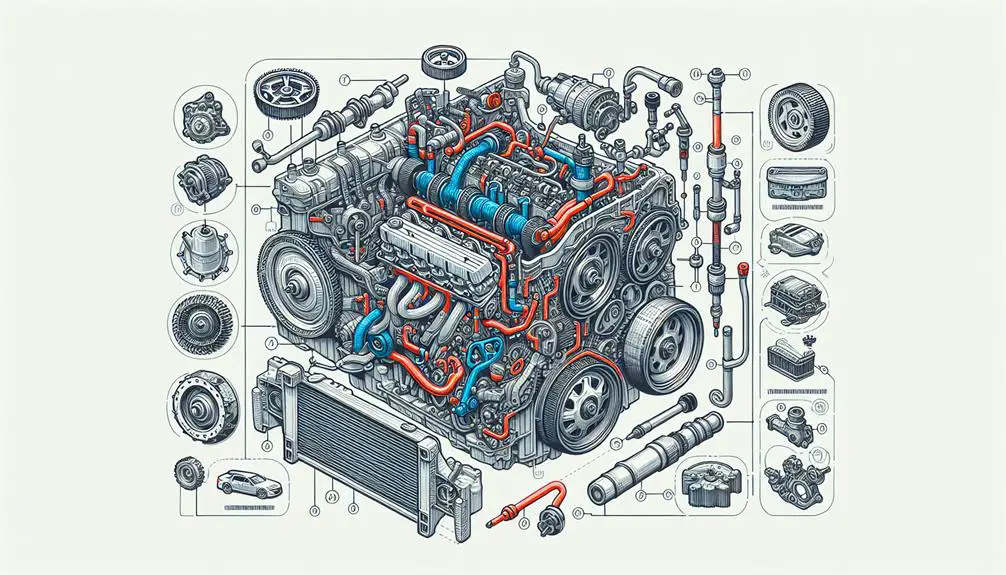The cooling system in a car prevents overheating by transferring heat away from the engine.
It circulates coolant through the engine and radiator to dissipate heat.
If the cooling system fails, the engine can overheat and cause serious damage.
Basics of Cooling Systems

A cooling system fundamentally works by transferring heat away from an object to maintain its peak operating temperature. You're dealing with a mechanism that's both intricate and critical, especially when considering its environmental impact and the potential for future innovations. Essentially, the efficiency of a cooling system not only dictates the operational effectiveness of the device it's cooling but also its ecological footprint. This is where the conversation pivots towards the environmental impact, emphasizing the importance of developing cooling solutions that minimize energy consumption and reduce greenhouse gas emissions.
As you explore deeper into the technical intricacies, it's important to recognize how future innovations play a pivotal role. Advancements in cooling technology aim to improve performance while simultaneously addressing environmental concerns. This involves exploring alternative refrigerants with lower global warming potential, improving heat exchange materials, and integrating smart systems for optimized energy use. The goal is to achieve a balance where cooling systems can deliver high performance without exacerbating environmental issues.
Your grasp of these fundamentals isn't just about knowing how these systems work; it's about appreciating the ongoing efforts to make them more sustainable and efficient in the face of global challenges.
Key Components and Functions
Comprehending the environmental implications of cooling systems sets the stage for an in-depth look at their key components and functions, which are fundamental in achieving sustainable and efficient operation. You're entering a domain where precision engineering meets rigorous demands for component durability and fluid dynamics optimization.
At the heart of these systems, the coolant is pivotal. This specially formulated fluid absorbs heat from the engine or environment it's cooling, transferring it elsewhere to prevent overheating. The role of fluid dynamics here can't be overstated. It's all about ensuring the coolant moves efficiently through the system, maximizing heat transfer while minimizing energy consumption.
Pumps play an important role, propelling the coolant through the system. Their design and operation are critical for maintaining the fluid's velocity and pressure, essential parameters in fluid dynamics that directly affect cooling efficiency and component durability.
Heat exchangers, another key component, help in the transfer of heat from the coolant to the air or another medium. The effectiveness of this exchange is directly related to the design of the exchanger, impacting the overall performance of the cooling system.
Through these components, cooling systems achieve a delicate balance between efficiency and environmental sustainability, showcasing the importance of understanding both component durability and fluid dynamics in their design and operation.
Types of Cooling Systems

Diving into the realm of cooling systems, you'll find they can be broadly categorized into air cooling and liquid cooling technologies, each with its distinct mechanisms and applications. While you might initially think of fans and radiators as the primary tools for temperature regulation, the field extends far beyond these basics. Here, we'll investigate the different types of cooling systems, focusing on their functionality and suitability for different applications.
- Air Cooling Systems: Utilize fans or blowers to circulate air over a hot surface, dissipating heat into the surrounding environment. They're commonly found in computer CPUs and automotive engines, offering a simple yet effective means of temperature control.
- Liquid Cooling Systems: Involve the circulation of a coolant fluid, which absorbs heat from components and transfers it elsewhere, often to a radiator where it's dissipated into the air. This category includes water cooling setups in high-performance computers and automotive cooling systems.
- Advanced Cooling Technologies:
- Geothermal Solutions: Exploit the earth's stable underground temperature for heating in the winter and cooling in the summer, presenting an eco-friendly option.
- Phase Change Materials (PCMs): Absorb or release heat during their transformation between solid and liquid states, providing efficient thermal management in various applications.
These systems showcase the diversity and innovation present in the field of temperature regulation, each offering unique advantages for specific environments and requirements.
Understanding Heat Transfer
To fully grasp how cooling systems work, it's important to understand the fundamental processes of heat transfer that govern their efficiency. At the heart of these processes are conduction basics and the role of thermal insulation. You'll find that conduction is the process through which heat moves through materials that are in direct contact. It's a principle that's vital in designing cooling systems, as materials with high thermal conductivity can quickly transfer heat away from critical components.
Thermal insulation, on the other hand, is designed to do the opposite. It prevents the unwanted transfer of heat into or out of the cooling system. By selecting materials with low thermal conductivity, engineers can effectively insulate components, ensuring that the system maintains the essential temperatures.
Understanding these concepts allows you to appreciate the delicate balance required in cooling system design. It's not merely about removing heat; it's about controlling how and where heat flows. This knowledge is foundational, setting the stage for more complex discussions on how cooling systems are maintained and troubleshot. But remember, the efficiency of any cooling system hinges on mastering these heat transfer basics.
Maintenance and Troubleshooting

Effective maintenance and troubleshooting are critical for ensuring your cooling system operates at peak efficiency and reliability. You've got to keep a keen eye on several aspects to prevent any unexpected breakdowns, especially when you're heading into extreme weather conditions or demanding operational periods. Here's how you can do it:
- Winter Preparation: As temperatures drop, the risk of coolant freezing increases, potentially causing severe damage to your system. To avoid this, make sure your coolant mixture is appropriate for your local climate. Regular checks and adjustments are necessary as winter approaches to safeguard against freezing and cracking within the cooling system.
- Coolant Additives: Utilizing the right coolant additives plays a significant role in maintaining the system's health. These additives prevent corrosion, scale buildup, and improve the coolant's boiling and freezing points. It's critical to analyze the coolant's chemical composition periodically and adjust the additives to maintain peak performance and protection.
- Routine Inspection and Cleaning: A systematic approach to inspecting and cleaning the cooling system ensures early detection of potential issues. Pay close attention to the radiator, hoses, and connections for any signs of wear, leaks, or blockages. Regular flushing of the system helps in removing any internal buildup and ensures the coolant's effectiveness.
Conclusion
Essentially, you've now navigated the intricacies of cooling systems, grasping their pivotal components and the diverse types available.
You've comprehended the critical process of heat transfer, crucial for efficient system operation.
Maintenance and troubleshooting are your allies in ensuring longevity and peak performance.
Remember, a well-maintained cooling system not only optimizes functionality but also notably improves energy efficiency.
Armed with this knowledge, you're better equipped to tackle cooling system challenges with confidence and precision.